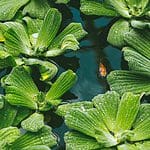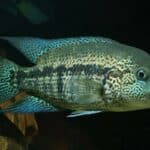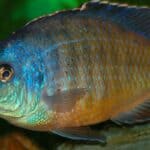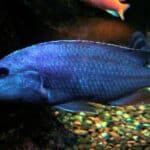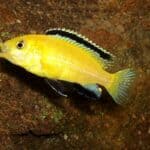The Jack Dempsey Cichlid, or Rocio octofasciata by its scientific name, is a beautiful freshwater fish, popular amongst aquarists for its curious coloration. This coloration can vary quite extensively, and can change due to age, environment and even mood.
In the wild, Jack Dempsey Cichlids hail from the murky, slow-moving streams and rivers of North and Central America, in particular Mexico and Honduras.
They have recently been introduced into the warm waters off Thailand and Australia, where the Jack Dempsey is known as the Mexican Blue Frontosa.

This fish gets its common name from the 1920s boxer Jack Dempsey, who was famously aggressive and had vivid facial expressions, much like these characterful fish.
As it is a rather feisty, carnivorous fish, it is not recommended as a sensible choice for beginner aquarists. However, those with a little more experience will get great enjoyment from having a Jack Dempsey Cichlid in their tank.
Care Guide
Tank Size
The minimum tank size for Jack Dempsey Cichlids is 80 gallons. This is due to the fact that they are incredibly territorial and need a lot of space to prevent them becoming aggressive with each other. As a gauge, each fish should have at least 55 gallons to itself, and that number should increase with each fish added to the tank.
Tank Mates
Although Jack Dempseys are notoriously feisty, this does not mean that you cannot successfully keep them in a community tank. You just have to be very selective about who you put them with.
Small fish like tetras are a bad choice because they will be instantly eaten or injured. The same goes for snails and shrimp, which will also be regarded as a tasty snack.
However, fish of a similar size to the Jack Dempsey, or indeed bigger, are a good option. Aggressive fish work particularly well because they can defend themselves and give as good as they get.
Oscar fish and Mbuna cichlids are a popular choice of tank mate, as are clown loaches, convict cichlids, blue acara, angelfish, silver dollars, plecostomus, and firemouth cichlids.
Same Species Tanks
It is possible to keep Jack Dempseys in a same-species tank, and some would say that this is the best option for beginners. However, keeping one Jack Dempsey on its own will inevitably be easier than keeping a group.
Jack Dempseys can quickly become aggressive with each other , especially if you have multiple males in one tank. Therefore, it is best to only have one male and multiple females cohabiting if you want a peaceful aquarium.
Water Parameters
In the wild, Jack Dempsey fish inhabit a range of slow-moving freshwaters such as murky canals, lakes, swamps and rivers. For this reason, it is best to keep the lighting in their tank low and shady so as not to stress the fish by making them feel overly exposed.
They prefer warm water temperatures as they are used to tropical climates. Therefore, you should aim to have a tank water temperature of between 72-86 degrees Fahrenheit. They also need slightly acidic water with a PH of between 6-7 and a water hardness between 9-10 dH.
If you maintain these water parameters properly then your Jack Dempsey fish will be pretty hardy and healthy aquarium residents.
What To Put In Their Tank
In order to mimic their natural habitat as closely as possible you should fit your tank with a filter that creates a very mellow current. It is not necessary to fit a water pump, as that will create too much movement in the water and distress your fish.
As aforementioned, Jack Dempseys prefer dim lighting, and plants will add to this feeling of security and cover. These fish like to hide amongst the vegetation as they would in the wild, therefore hornwort is a great option, as are other floating plants.
The fish shouldn’t dig and tear up the plants like some aggressive species do, however, they have been known to suddenly change their mind on this matter and pull up plants without explanation.
An important addition to any Jack Dempsey fish tank are caves and rocks. These fish really do love to hide and feel like they can retreat for some downtime when they need to, therefore providing little nooks and crannies will keep them content and improve their behavior.
A soft, sand-based substrate is the best option for these fish because they tend to spend a lot of their time on the bottom of the tank and anything too rough will irritate their bellies.
Common Diseases
Jack Dempseys suffer from all the usual freshwater diseases such as Ich and HLLE (Head and Lateral Line Erosion). Ich is a parasitic disease common amongst freshwater fish and presents itself as white spots on the fish’s body.
To treat it you can raise the water temperature in the tank to 86 degrees. HLLE is usually brought on by bad nutrition, and presents itself as tiny pits in the fish’s head. If spotted you should change your fish’s diet to rectify the situation.
In general, you can keep your fish healthy by maintaining a clean, constant water quality and providing the right food and tank mates for them. Perform regular water tests to check up on the parameters, and weekly water changes to keep the tank fresh.
Another important practice is to quarantine any new fish or plant before introducing it to an established tank, as this is where most new infections originate.
Food and Diet
Jack Dempseys are carnivorous fish and you therefore need to provide them with a protein-rich, meaty diet. In the wild they love to munch on worms, small fish, insects and crustaceans. In a tank you can give them meaty flakes and pellets, but should also occasionally offer them live and frozen foods to ensure they get all the nutrients they need.
Brine shrimp and bloodworms are both great options, and crickets, fruit flies and grasshoppers will also go down a treat!
Jack Dempsey fish tend to turn their nose up at omnivore foods, which is why it is fine to plant vegetation in their tanks. But as carnivores go, these guys are not picky and will pretty much gobble up whatever you put in front of them.
Ideally you should give these fish as much food as they can eat in two minutes, and you should feed them 1-2 times a day.
Juveniles should be fed 2-3 times daily in order to help them grow.
Lifespan
Jack Dempsey fish tend to have a lifespan of 8-10 years, which is plenty of time for you to become quite attached to them. Some owners have even reported their Jack Dempseys living up to 15 years with the right care and attention.
Appearance
It is the Jack Dempsey’s unique appearance that makes them such a popular choice with fishkeepers. They have large oval bodies with lengthy fins, and they come in a range of colors, the favorites being blues, pinks and golds.
What is fascinating is that their colors change with age. Young Jack Dempseys tend to be grey-ish blue with green flecks, whilst more mature fish become a purpley-grey with vibrant blue flecks. Even more amazingly, these fish change color according to mood and situation.
When mating their colors become more pronounced and deeper in tone, whilst when stressed they become paler.
One very popular variety of Jack Dempsey fish is the electric blue Jack dempsey. These guys tend to be a bit smaller than other Jack Dempseys and also less aggressive.
Size
On average, Jack Dempsey Cichlids grow to between 10-15 inches long, with females growing slightly shorter than males.
Behavior and Temperament
Although the species is notorious for aggressive behavior, Jack Dempsey Cichlids can actually be rather shy and skittish when first introduced to a tank. These fish love to hide under rocks and amongst plants, and spend much of their time at the bottom of the tank. They do also swim about in the middle section of the water column, but rarely come to the surface.
Male Jack Dempseys like to establish territory by lashing out at other fish. However, if you provide plenty of caves and crevices to go round, there shouldn’t be too many disputes.
Breeding
It is easy to tell when Jack Dempsey fish are ready to mate as their colors become darker and more defined. Unfortunately, if a male is ready to mate before a female, she may be violently harassed and even killed.
However, if mating is successful, as many as 500 eggs can be produced! These eggs become attached to flat surfaces like wide leaves, the aquarium walls and the sandy substrate.
Approximately 3 days later, they hatch and the parent fish become surprisingly attentive towards the fry. They dig holes to protect them until they can swim freely, and they even crush up food for the fry to eat.
However, if the parents become distressed due to poor conditions, they will turn on their young and eat them – so keep mum and dad happy!
Gender Differences: Male vs Female
Males tend to be larger than their female counterparts, and have longer dorsal and anal fins. Their fins are also more pointed, whereas females have less sharp and pronounced fins.
Fun Fact
Did you know: the real Jack Dempsey won the 1919 title of Heavyweight Boxing Champion of the World! No wonder he had such a feisty fish named after him!

